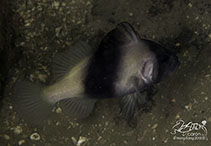| Family: |
Liopropomatidae (Painted basslets), subfamily: Diploprioninae |
| Max. size: |
25 cm TL (male/unsexed) |
| Environment: |
reef-associated; marine; depth range 1 - 100 m |
| Distribution: |
Indo-West Pacific: Maldives and India to Papua New Guinea, north to southern Japan, south to Lord Howe Island (Ref. 9710). |
| Diagnosis: |
Dorsal spines (total): 8-8; Dorsal soft rays (total): 13-16; Anal spines: 2-2; Anal soft rays: 12-13. Body compressed, its width 3.3-4 in depth (Ref. 37816). Normally yellow, but sometimes nearly all black and juveniles take-on colors of the local venomous Meiacanthus blennies that are yellow or grey (Ref. 48635).
Description: Characterized by having mainly ctenoid body scales; relatively deep bodied; coarsely serrate preopercle margin; rounded caudal fin; elongated pelvic fins (Ref. 90102). |
| Biology: |
Found mainly in coastal habitats in semi-silty conditions (Ref. 48635); also found near caves and crevices in rocky and coral reefs from a few meters to at least 100 m. A predator that feeds on surprisingly large prey, swallowed whole through its expandable jaws (Ref. 48635). Feeds mainly on fishes. Secretes the skin toxin grammistin under stress (Ref. 2334). |
| IUCN Red List Status: |
Least Concern (LC); Date assessed: 10 March 2015 Ref. (130435)
|
| Threat to humans: |
venomous |
Source and more info: www.fishbase.org. For personal, classroom, and other internal use only. Not for publication.

